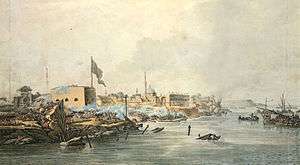Siege of Izmail
| Siege of Izmail | |||||||
|---|---|---|---|---|---|---|---|
| Part of Russo–Turkish War of 1787–1792 | |||||||
| |||||||
| Belligerents | |||||||
|
|
| ||||||
| Commanders and leaders | |||||||
|
|
| ||||||
| Strength | |||||||
| 31,000[1] | 40,000[1] | ||||||
| Casualties and losses | |||||||
| 1,815 killed, 2,445 wounded[1] | 26,000 killed, 9,000 captured[1] | ||||||

The Siege of Izmail was fought in 1790 on the Black Sea during the Russo-Turkish war of 1787–1792. The Russians were led by Alexander Suvorov, who had defeated the Ottomans at Kinburn, Ochakov, and Focsani. The Black Sea flotilla was commanded by the Spanish admiral José de Ribas.
In March 1790, the Russians began besieging Izmail, in the region of Budjak (now in Ukraine), which had a garrison of 40,000 soldiers. Suvorov had 31,000 troops and on the morning of 22 December 1790, the Russians began attacking the city. They bombarded Izmail until 3:00 A.M. And then stormed it at 5:30 A.M. The Russians advanced on the north, east, and west.[1] The walls were weaker there than in other places, where it took Russian troops longer to attack. By 8:00 A.M. the Russians had entered the city. In total the Ottoman forces had more than 26,000 killed with the whole garrison being killed, wounded or captured. The Russian forces suffered only 4,330 casualties, out of which 1,815 were killed.[1]
To the victory was dedicated the anthem "Grom pobedy, razdavaysya!" (Let the thunder of victory sound!) which was an unofficial Russian national anthem in the late 18th and early 19th centuries. Today it is commemorated as a Day of Military Honour in Russia.